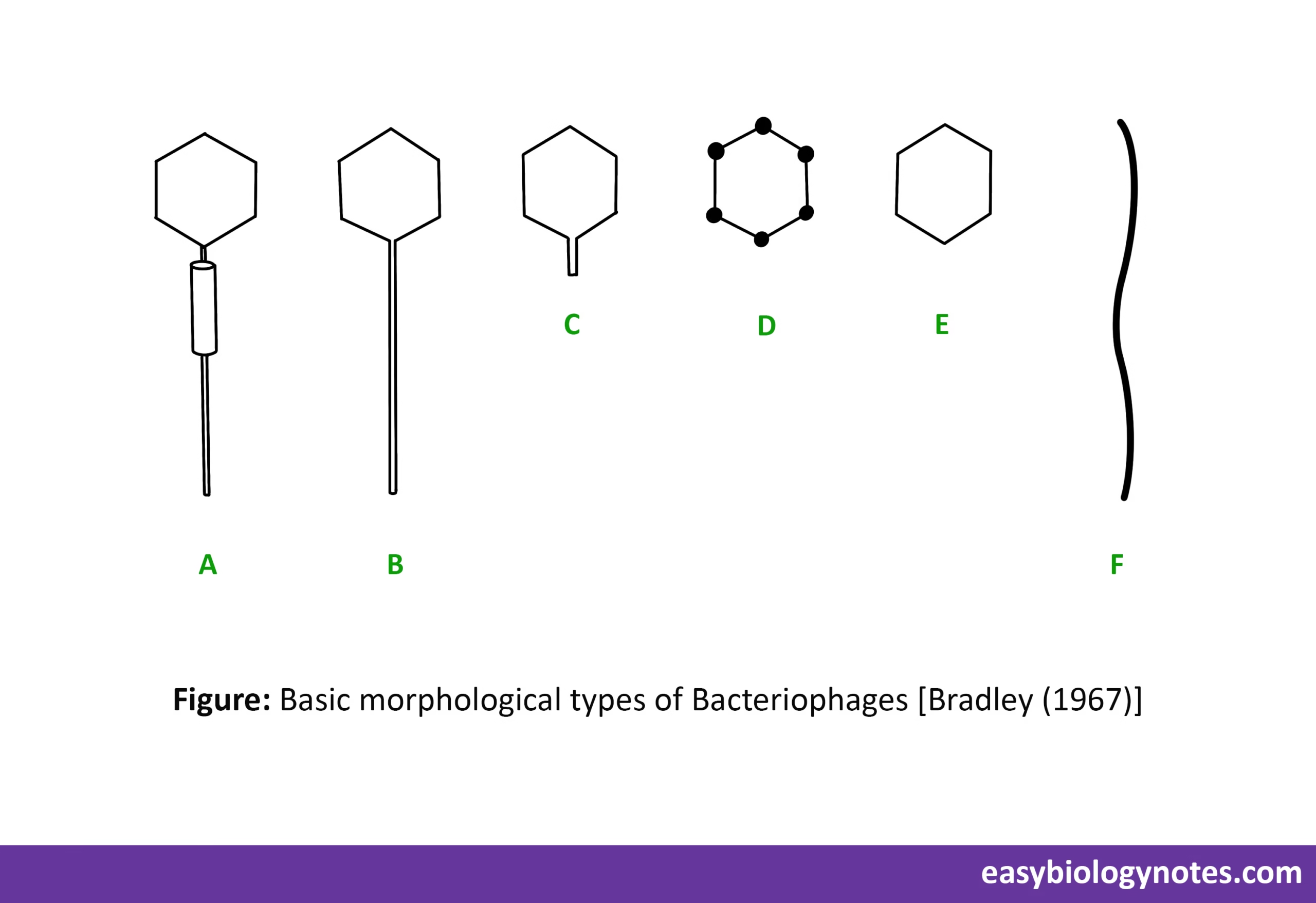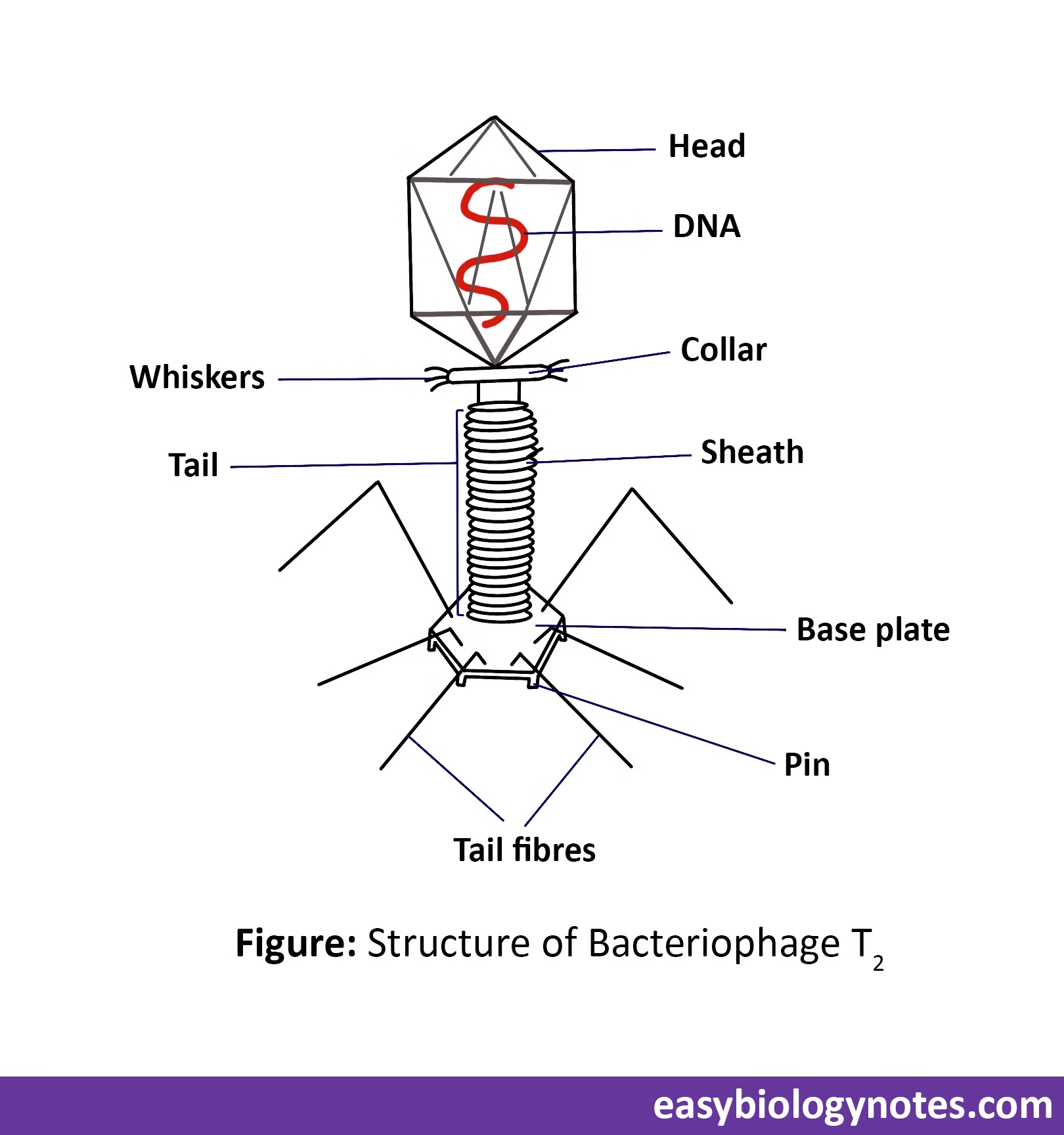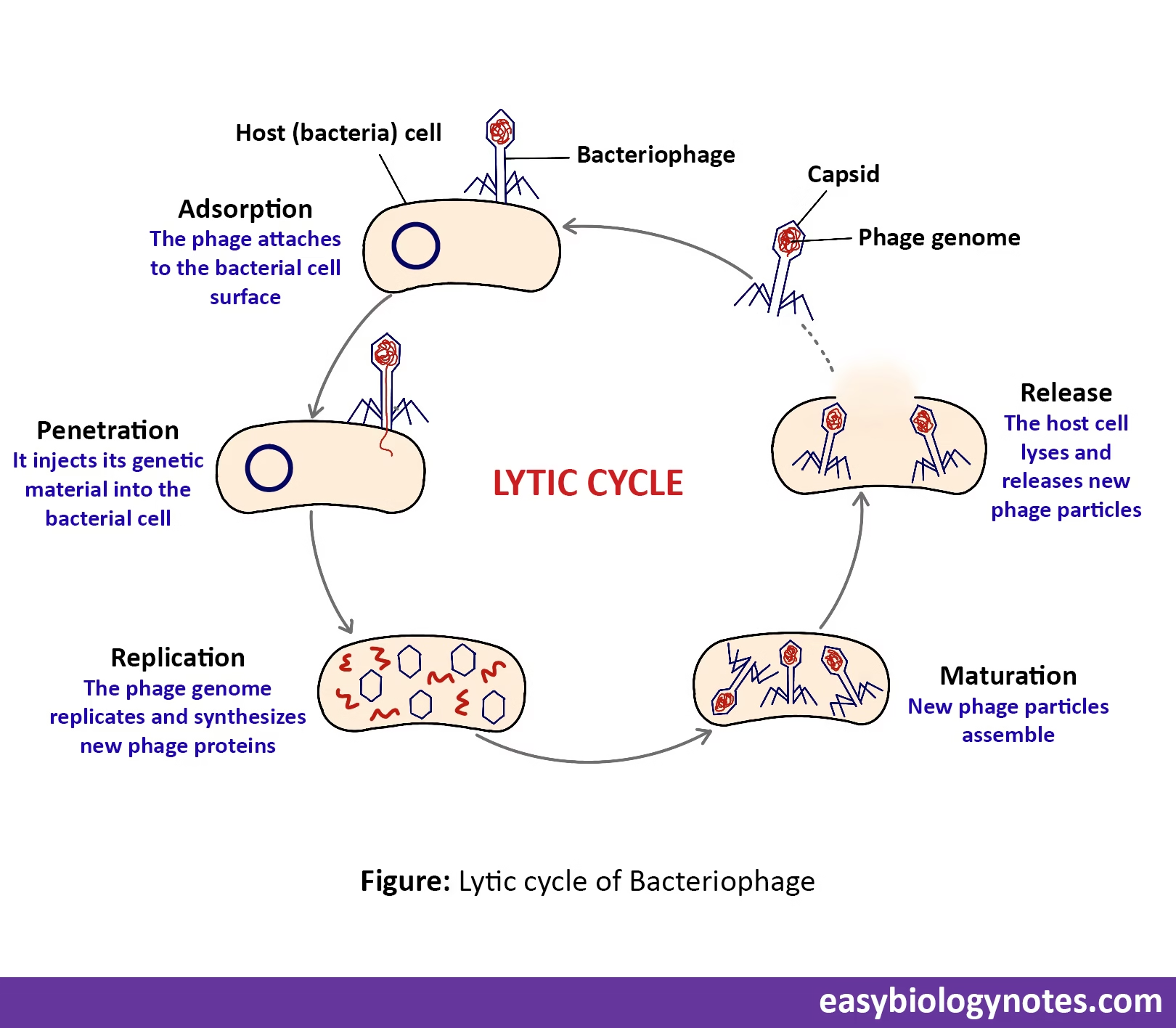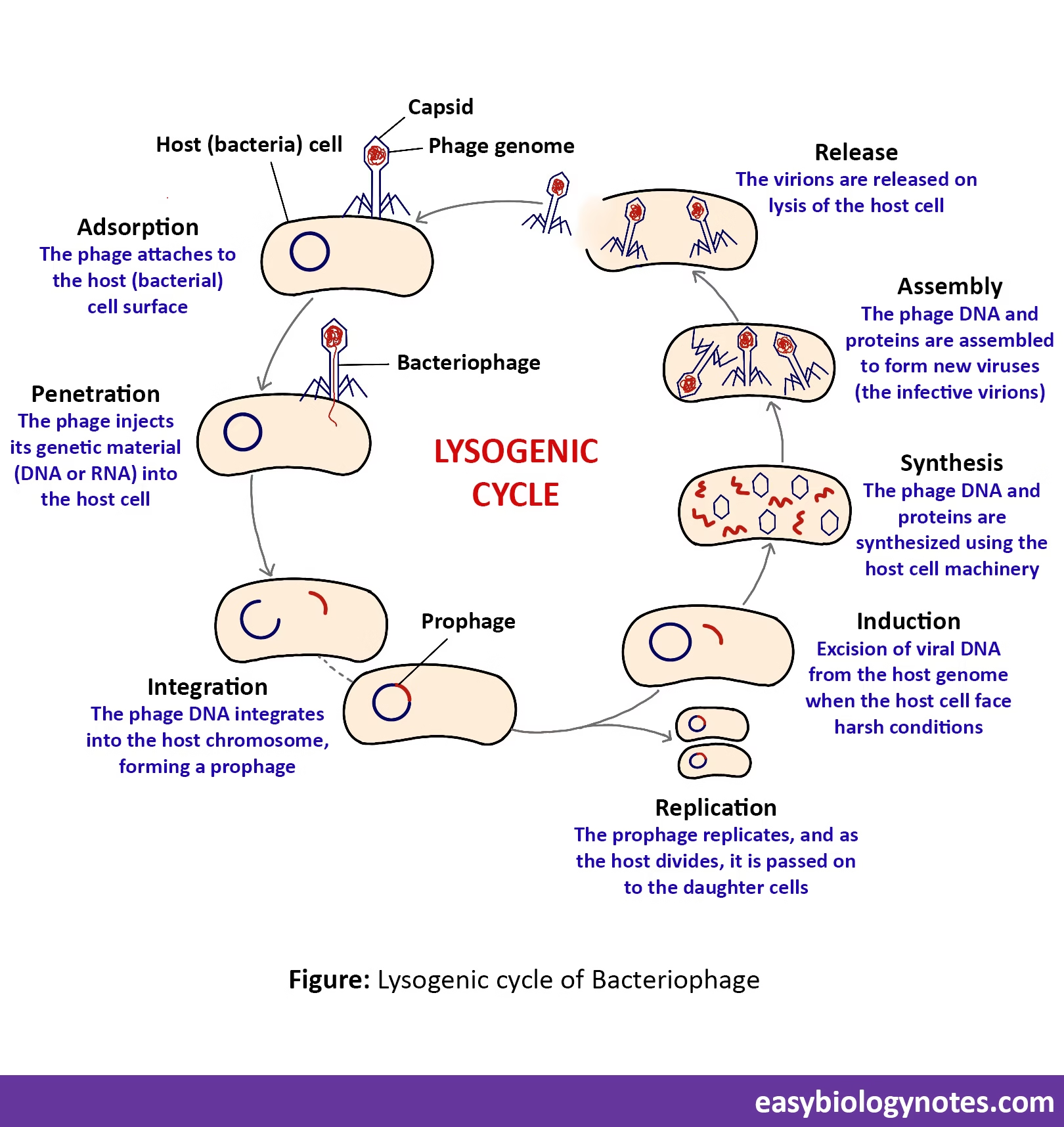What are Bacteriophages?
- The viruses which infect bacterial cells are called Bacteriophages or simply Phages.
- These are the viruses that parasitizes the bacteria.
- Bacteriophages were discovered independently by Frederick William Twort in 1915 and Félix d’Hérelle in 1917. (Twort first discovered phages in 1915 while Herelle, in 1917, discovered that they had the potential to kill bacteria)
- Félix d’Hérelle coined the term ‘Bacteriophage’ which literally means “Bacteria eater”.
Morphological types of Bacteriophages
- Morphology of phages varies. Bradley (1967), in a classic review paper, summarized the principles of phage morphology and outlined six basic morphological types:

- The tailed phages (Groups A–C) account for some 96% of all phages isolated to date.
- Only phages in Group A have contractile tails.
- All tailed bacteriophages have a nucleic acid core surrounded by a protein coat.
- Phages belonging to Groups A, B, and C contain double-stranded DNA; phages in Groups D and F contain single-stranded DNA. However, Group E phages contain single-stranded RNA.
Ultrastructure of Phages (T₂ bacteriophage)
- The T₂ phage is small, having a tadpole-like structure.
- Body is differentiated into head, collar, and tail.
- Capsomeres make an envelope enclosing viral DNA.
- Tail consists of the following parts:
- A central helical hollow tube (also called the central core) through which viral DNA passes during the infection of the host cell.
- Core is surrounded by a proteinaceous contractile sheath capable of contraction.
- The distal end of the sheath is connected to a hexagonal base plate having pins at every corner.
- Basal plate contains tail fibers at its six corners, which are the organs of attachment to the wall of the host cell.

Life cycle of Viruses (Bacteriophages)
Depending upon the interaction of phages with the bacterial cells, the life cycle of viruses has been distinguished in two major types: i) Lytic cycle, ii) Lysogenic cycle
Lytic Cycle:
- Also known as Virulent cycle.
- This is a type of life cycle where the viral DNA remains as a free-floating molecule and replicates separately from bacterial DNA. (Bacterial DNA gets degraded)
Lysogenic Cycle:
- Also known as Temperate cycle.
- This type of life cycle is characterized by the incorporation of the bacteriophage genome into the host genome.
[1] Lytic Cycle
- In the lytic cycle, a bacteriophage infects a bacterium and kills it to release progeny virus.
- This type of cycle is seen in T-even phages (T2, T4, etc.) which attack Escherichia coli.
- The lytic cycle consists of five steps:
i) Attachment:
- The bacteriophage attaches itself on the surface of the bacterium (adsorption). The tips of the tail fibers attach to specific receptors, e.g., lipopolysaccharides, OmpC protein on the host surface (bacterial cell).
- The tail fibers then bend and allow the tail pins to pierce through and attach on the host surface, making an irreversible attachment.
ii) Penetration:
- Lysozyme digests the host cell wall, and the tail sheath contracts, acting like a hypodermic needle to inject the viral genome (DNA) into the host cell.
- The phage head and remaining components remain outside the bacterium, called ghosts or doughnuts.
iii) Biosynthesis of New Viral Components:
- After entering the host cell, the virus synthesizes virus-encoded endonucleases to degrade the bacterial chromosome.
- It hijacks the host cell machinery to replicate, transcribe, and translate the necessary viral components (capsomeres, sheath, base plates, tail fibers, and viral enzymes) for the assembly of new virus progeny.
iv) Maturation and Assembly:
- On maturation, the head and tail units of phage particles are synthesized, and the phage DNA gets enveloped by the protein coat of the head.
- Ultimately, the tail structure also gets added. (Initially, the core tube is attached to the basal plate and then sheath becomes assembled around the core tube, forming the tail region.)
- The tail becomes attached to the base of the head, taking a collar in between. At last, the tail fibers are attached to the basal plate.
v) Release
- The infected bacterial cell is lysed releasing the progeny phages into the environment to infect new cells.
*The phage enzymes weaken the cell wall of bacteria during replication.

[2] Lysogenic cycle
- A. Lwoff (1953) discovered this type of cycle in Lambda phage.
- The phage involved in this cycle is called temperate phage.
- In a lysogenic cycle, the phage genome enters the cell through attachment and penetration.
- During the lysogenic cycle, instead of killing the host, the phage DNA integrates into the bacterial chromosome and becomes a part of the host. The integrated phage genome (DNA) is called a prophage.
- A bacteria carrying a prophage without being lysed is called a lysogen, and the process is called lysogeny.
- As the bacteria replicate its chromosome, it also replicates the phage’s DNA and passes it on to new daughter cells during reproduction.
- The presence of the prophage may alter the phenotype of the bacterium since it can bring in extra genes. This change in the host phenotype is called lysogenic conversion or phage conversion.
- During lysogeny, when the host cell faces harsh conditions, then the prophage shows induction, which results in the excision of the viral genome from the host chromosome.
- After induction, the temperate phage follows the lytic cycle and then again undergoes lysogeny in a newly infected cell.

Note:
The lytic cycle doesn’t allow genetic recombination of the host chromosome, whereas the lysogenic cycle allows the genetic recombination of the host chromosome.
Economic Importance of Phage Particles
- Phages have been used in prophylaxis and treatment against dysentery, enteric fever, cholera, plague, and many other pathogenic bacterial diseases.
- Phages are also used in the diagnosis of certain infections.
- The causative agents of plague, cholera, etc., can be determined with the help of special phages.
- Phages are helpful in the lysis of bacteria present in polluted water. Hence, they can also be used as scavengers.
- In space microbiology, lysogenic cultures are used as radiation detectors. They were used by Russians in the spaceship Vostok 2.
- Temperate phages help in the transduction of genetic material from one bacterial cell to another. They are also widely used as models in genetic research.
- Phages are often very harmful as they kill beneficial microorganisms by the lysogenic activity during the process of manufacturing antibiotics and milk products.